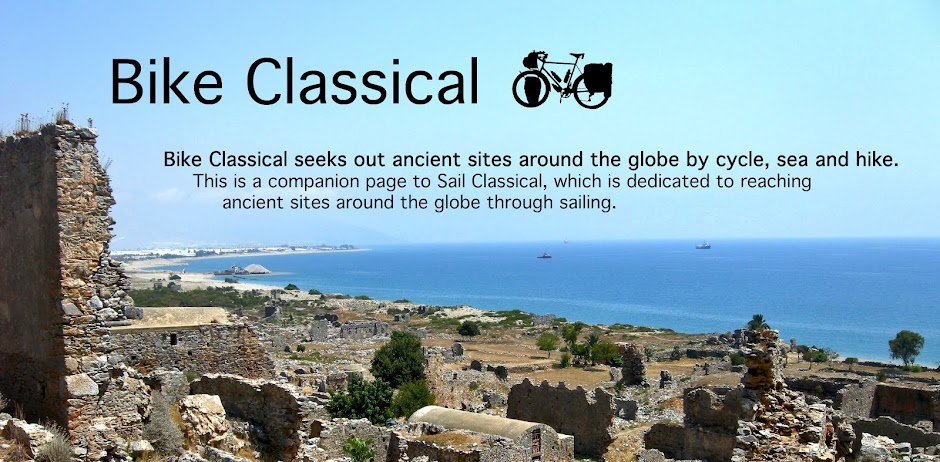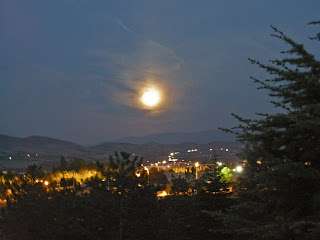Photos by Jack A. Waldron
'Eski' (seen in the road sign above, translates into 'old' in Turkish, and Malatya, well, that is not exactly correct, because the sign is referring to ancient Melitene. Malatya proper was founded during the 19th century, and is located about 10 km in the opposite direction from where my bike is pointing in the photo above.
Pictured above, a large scale model of Mount Nemrut can be seen in downtown Malatya. If you ever have the opportunity to drive (or, cycle!) from Malatya to Nemrut, there are two amazing back mountain routes that can be taken to the site. One of the routes (highly recommended!), can be accessed by a side road that skirts the eastern edge of the campus of Inonu University, which leads off from the main highway (I will expand on this route in a future post). The second route is another offshoot from the main highway as you head north out of Malatya. There is an old dilapidated wooden sign that points the way.
A usual site in many cities and villages in the east of Turkey is wool being hung out to dry after washing (pictured above). While not cycling the winter months, I had the great opportunity to base myself in Malatya, and teaching at TED (TED conference in Malatya, pictured below) for three years before changing my winter base to Ankara, and teaching at ODTU CIS.
TED was very generous to its teaching staff, like most schools in Turkey. We were given two formal dinners per year, open bar (limit two drinks, whoops! Thank you!!), and lots of swag. The foreign English teachers I worked with lasted only 1 to 3 years, but we are still in contact, having experienced Eastern Turkey . . . , and TED, together.
The full moon pictured below was taken from the tennis court buildings at TED Koleji on the Inonu University campus. If you follow the moon directly down to the headlights of the cars on the main highway, here you will find the small road that leads off to the right side of the photo into the mountains, and to Mount Nemrut.
Although you cannot gather the complete experience of the valley that this moon is rising above, let me assure you, it is spectacular, especially during the green of Spring. Till this day, I conjure up images of the great armies of the Urartians, Armenians, Greeks, Persians, Asyrians, Romans, Byzantines, Seljuks, Crusaders and more, marching through this valley to do battle at Arslan Tepe, Milid, and Melitene.
Pictured above and below, my fellow teacher (art) and brilliant painter, Yılmaz Çavuş, who ALWAYS made me smile and cringe at the same time!! Certainly, a much more lovable character than myself. His Adıyaman tobacco was so strong, that non-filter Camels or Lucky Strike were a walk in the park, because after taking a puff, you couldn't walk!! I miss you my friend!
A Roman legion was once disabled after hallucinogenic honey from the northeast of Anatolia was consumed by the unsuspecting troops . . . , well, that honey is consumed daily in Ordu, and sometimes you have to beat the crazies off with a shoe!!
Certificates galore!! There is no end to the conferences, symposiums, and training seminars, when you work with the top schools!
More crazies!!!
The crew!!
Our tennis court apartment, while short lived, was next to the schools garden!! Everything is appreciated, especially when you are saving for a sailboat on a teacher's salary!
We used to do an old school ESL activity in my 7th grade classes . . . , SOCK PUPPETS!! I still have a bag full of sock puppets, and I hate to just throw them away, so, I think I will include them with gifts I give. Everybody loves a sock puppet!!
My daily routine, 45 minutes hard cycling, then, 10 minutes HIT training, then 20 minutes free weights and machines, including 3 sets with 3 different weights. I always tell people, I want to be Jack Lalanne when I'm 75 years old, not Orson Wells, physically that is!!
This was a gym in Malatya, and a funny story (though not so funny at the time), was that the gym owner would let his 2 year old ride his electric toy car all around the machines, and whenever he saw me he would start balling his eyes out. Well, the owner blamed me, and I was forced to leave the gym after 2 years training there!
Marco from Italy was cycling through Malatya, and found me on Warmshowers! This amazing sportsman has done it all. He climbs the highest peaks, and cycles the steepest roads. We enjoyed some nice Turkish red wine with our pesto whole wheat pasta!
Well, back to Battalgazi, or, Eski Malatya, or, Melitene, which all refer to the same location. As you read in Pt.1, this site has been fought over for millennia, as it was the entry/exit point between east and west for many many centuries.
Here, we'll take a look at some of the post-Byzantine structures that are scattered around the ancient city. Pictured below, the 17C Mustafa Pasa Han, with a large courtyard surrounded by porticoes for the sale of goods.
I think it will do to simply let the photos do the talking here . . .
You can see Mustafa Pasa Han at the end of the main street in the photo above. This is obviously the gathering point of tourists who visit the ancient city, though it is usually quite quiet. There are countless tourist destinations such as this throughout the country. With the vault of Lady Nefise, we begin to step further back in time toward the Byzantines (pictured below).
As far as I can tell, a decent job has been done on the restoration of the 14C vault of Lady Nefise, but as you will see below, there are numerous post-Byzantine era monuments that are waiting in line to be restored.
Ancient minarets can be seen throughout the city, most in dire need of repair and restoration. Unfortunately, there are no sign posts to give a history of these monuments, so I will have to spend time digging deeper, and update the post at a later time.
If my untrained architectural eye doesn't deceive me, I would say that the minaret pictured below was a direct descendant of the one pictured above.
Not far from the minarets pictured above are the remains of the Islamic Theological School of Sahabiyye-i Kubra (pictured below). Referred to as a 'madrasah', remains of these ancient religious schools can be found throughout Turkey.
Behind the school are the remains of a tomb (pictured below). Though I could speculate that the tomb once held the remains of the founder or patron of the school, I will have to do more research in order to give an accurate history.
Picture below, we are now looking south, with the madrasah iwan of the Islamic Theological School of Sahabiyye-i Kubra in the foreground, and with one of the minarets discussed above partially hidden by the tree in the left of the photo.
Iwan simply refers to a vaulted hall space with three walled sides, with the front side completely open, and projecting out from a building facade. It is believed that the iwan as an architectural invention comes from the Partians, and is representative of a portal. Pictured below, the iwan of the Ameri House in Khasan, Iran.
Pictured below, what appear to be remnants of the elaborately decorative and ornately sculpted iwan of the Islamic Theological School of Sahabiyye-i Kubra, here incorporated into a crudely constructed wall along the street in front of the structure.
The wall, which was probably erected during the Ottoman era, was constructed from a mishmash of materials quarried from numerous structures built over many centuries, including Roman, Byzantine, Seljuk, etc., as well as the defensive walls of the city.
Directly across the street from the Islamic Theological School of Sahabiyye-i Kubra we find a much more recently built mosque (pictured below). Not surprisingly, the wall surrounding the mosque may have some components that look vaguely familiar, that being the nicely sculpted square blocks that would seem to have been harvested from the cities defensive walls.
*All photos and content property of Jack A. Waldron (photos may not be used without written permission)
**If you'd like to help with future postings, please feel free to support them through PATREON:





































